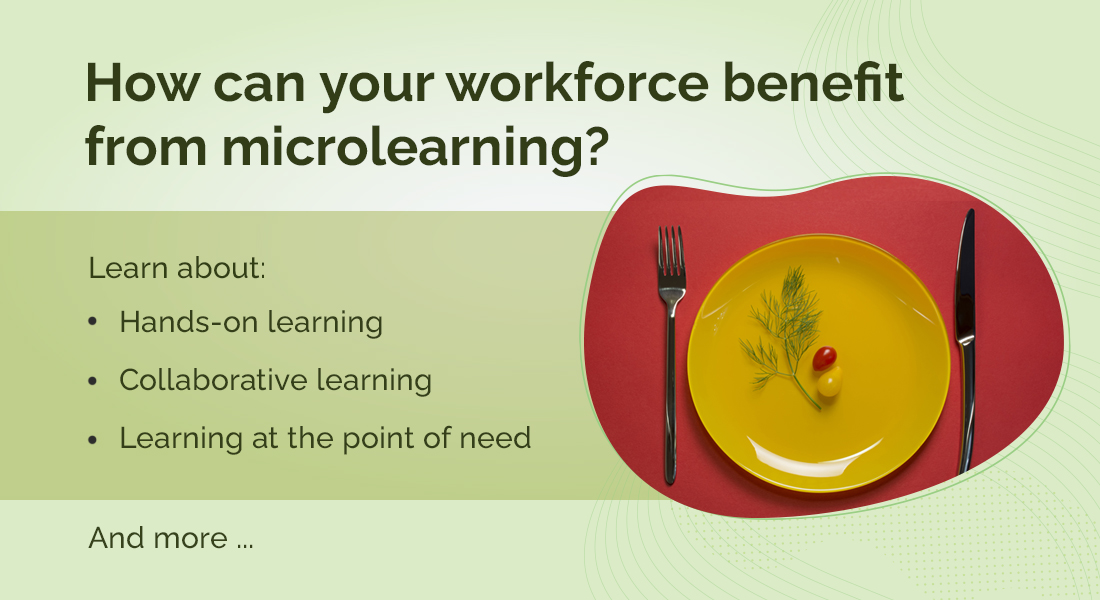How Short Learning Modules Lead to Improved Training Effectiveness

Learners of all ages seem to have shorter and shorter learning spans, particularly online. One solution to this is, offering Short Learning Modules that divide learning into digestible, bite-sized chunks. Commonly called as microlearning in the learning and development (L&D) circles, this trend allows learners to access information whenever and wherever convenient.
But, how does microlearning help your training strategy?
What makes it a hot choice for improving training effectiveness?
Let us see.
Nuggets of Information are Easy to Digest
Learners typically don’t prefer dealing with time-consuming content that is inundated with text or difficult to comprehend. Instead, learners fancy bite-sized or smaller chunks of information, that is easier to process and retain. Short, digestible nuggets are also the answer to information overload. They are well-suited for learners who have less time on their hand, for training. It is also handy for learners who need a refresher or a quick update, without having to spend an hour, sifting through reams of information.
Increases Psychological Engagement
Short learning modules act as an ideal solution to boring e-learning, by increasing their psychological engagement. Instead of a long, 60-minute delivery, learners are motivated to consume short, yet meaningful content.
Let me offer you a more science-y account of why this happens. Physiologically, our neurons are keen and on the alert for no more than 20 minutes. At the end of those 20 minutes, neurons have gone from full-fledged alert to total collapse, and it takes two to three minutes for those neurons to completely recover and get back to the total alert state. If you break longer than three minutes, you’ve redirected your attention.
Good Means to Offer Just-in-Time Support
Microlearning gives great on-the-job, just-in-time context, to help employees apply what they learn. How? Because it helps organizations train employees with only the need-to-know information, in order to do perform well in their jobs. For example, if a learner needs a quick and readily-accessible resource on how to perform a specific function, they could simply watch a brief video that boils down the information to the most important points.
Just-in-time modules – similar to microlearning – are short, punchy and effective. Also, they work with any format: videos, simulations, games, or step-by-step instructions; you can customize how you want to offer JIT, so that your learners only access the sections they need. However, it is vital that you have a clear goal in mind when implementing JIT training. You should know what your learners are lacking and what exactly they need, to meet their objectives, and then devise short, to-the-point resources that resolve or address each of these issues and present that information in an engaging manner.
Shorter Modules, but Same Rich Media
No matter how your learners learn, you need to engage them with the content they’re learning and the usage of rich media allows for that. Rich media makes learning more engaging and impactful, than plain text. Learners are bound to retain information better through media than from just reading text, because visuals are processed faster within the brain than anything written.
Integrating rich media into informal learning can help keep engagement levels high and retain skills quickly. Here are some of the examples of rich media elements that make microlearning impactful and engaging:
- Interactive videos
- Podcasts
- Screencasts
- Game-based quizzes
- Infographics/Interactive PDFs
Adapts to Modern-Day Learners
The modern day learner is distracted, overwhelmed, and impatient. They fancy information that doesn’t take up much of their time, which is to say that they thrive on instant gratification. According to a study conducted by Bersin by Deloitte, the average modern learner spends only 1% of their time on training, which translates to 4.2 minutes a day.
As training managers, you must take into account that your learner base is mostly comprised of Smartphone users, and realize the potential benefits of offering microlearning through mobiles to satisfy their training needs. When you make these short learning modules available on their mobile devices, your learners have the entire training content in their pocket, and more importantly, have full autonomy over training.
Roll Out is Easy and Less Time-Consuming Due to Their Modular Nature
Because microlearning is modular in nature, they are easy to roll out. They can be deployed much quicker than traditional e-learning. Also, on account of their run length and the typical formats used to develop microlearning modules, these assets have a much shorter development cycle.
Most of the microlearning modules support multi-device delivery, i.e., they can be accessed from desktops, laptops, tablets and Smartphones. If you host your courses on a Learning Management System (LMS), you can easily deliver microlearning modules to all your mobile device-users with the push of a button.
Maintaining high employee retention rates is an important aspect of sustainable organizations. To achieve this, it is important that your employees/learners feel they are in control of how they access learning. Microlearning is learner-driven wherein it enables them to choose when and where to learn, at the same time allowing them to learn at their own pace. This makes it the ideal format to improve your training effectiveness.





